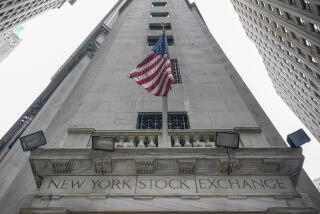$11-Billion Loss in S&L; Deposits Tied to Unease
- Share via
WASHINGTON — Public nervousness about the safety of savings and loan associations played an important role as deposits at the nation’s S&Ls; declined by at least $11 billion in January and February, federal officials said Wednesday.
Members of the Federal Home Loan Bank Board, testifying to the Senate Banking Committee, carefully avoided calling the withdrawals a “run.”
Instead, using much blander references to S&L; “liquidity” problems, they attributed the massive withdrawals to a combination of high rates offered by money market funds and extensive publicity about the financial plight of many of the nation’s S&Ls.;
Sees Bush Plan as Solution
Separately, Treasury Secretary Nicholas F. Brady told the Senate Budget Committee that unease over the nation’s savings institutions would evaporate if Congress approved the Bush Administration plan to arrange the shutdown or sale of hundreds of insolvent thrifts.
“Our conviction is that the outflow is due to all the publicity,” Brady said. “It would be hard to measure this period as a normal period. It’s our feeling (that) once this plan is adopted . . . this outflow will stop.”
However, any continued decline in deposits could increase the cost of the Bush Administration’s S&L; rescue plan, which assumes that S&L; deposits will rise.
Preliminary bank board figures show that S&L; depositors withdrew a net $7 billion in January and $3.7 billion for the first 20 days of February. The total for February may reach $4 billion to $5 billion, bank board Chairman M. Danny Wall told the Banking Committee.
Bank board officials held rising interest rates responsible for much of the outflow from S&Ls;, which are typically slower than money market funds to boost the rates they offer depositors. They said many S&L; customers whose certificates of deposit matured in January and February rolled the cash into money market funds instead of new CDs.
“It is not a loss of confidence,” said bank board spokesman Karl Hoyle. “We think people are responding to economic conditions.”
But he also noted that withdrawals often “spike up” in cities where insolvent S&Ls; are seized by the government. There was a surge of withdrawals in Texas, where uneasy depositors have been witnessing a wave of S&L; takeovers and shutdowns.
President Bush and Congress have pledged time and again that the government is absolutely committed to protecting S&L; deposits, which are guaranteed up to $100,000. No deposits have been lost under this insurance system, and the Federal Reserve has established an unlimited line of credit for troubled S&Ls.;
Despite all the reassurances, many depositors remain nervous. Many members of Congress, government agencies and the S&Ls; themselves are receiving numerous calls and letters inquiring about the safety of particular institutions.
The net loss of at least $11 billion during the first two months of the year represents barely more than 1% of the industry’s total deposits of approximately $1 trillion. But it nevertheless represents a disturbing trend that began in the last two months of 1988, when S&Ls; lost a net $15 billion in deposits.
The figure for last November and December included an intentional $3-billion reduction at First Nationwide Bank of San Francisco, a subsidiary of Ford Motor Co., which decided to raise funds by issuing commercial paper and other forms of borrowing. Because of its financial strength, First Nationwide was not forced to emulate other S&Ls; and offer unusually high interest rates on savings to attract deposits.
The January and February losses represent “really preliminary ‘guesstimate’ type numbers,” said James Grohl, senior vice president of the U.S. League of Savings Institutions. In February, he said, the Administration’s consideration of a plan, later discarded, to tax S&L; deposits as part of a savings industry bailout plan “scared a lot of depositors.”
At the Senate Budget Committee, Chairman Jim Sasser (D-Tenn.) praised the Administration for moving quickly to offer an S&L; rescue plan but predicted that its cost to the taxpayers would be much higher than the Treasury has estimated.
The taxpayer contribution to the rescue would be $76.8 billion over the first 10 years of the program, instead of the $39.9 billion estimated by the Administration, Sasser said in a memo prepared for the hearing.
He attributed the difference to the Administration’s overly optimistic projections of interest rates and the growth of deposits at S&Ls.;
Higher rates would add to the interest costs on the bonds that are to be sold to finance the Administration’s bailout program.
And a slower-than-expected growth in savings deposits would mean that the government would receive less revenue than it projects from the tax on deposits that helps pay for federal deposit insurance. The decline in S&L; deposits in the last four months appears to detract from the credibility of the Administration’s projection.
More to Read
Inside the business of entertainment
The Wide Shot brings you news, analysis and insights on everything from streaming wars to production — and what it all means for the future.
You may occasionally receive promotional content from the Los Angeles Times.









